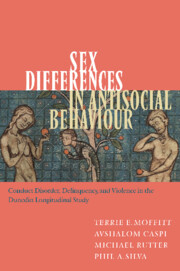 Sex Differences in Antisocial Behaviour
Sex Differences in Antisocial Behaviour Published online by Cambridge University Press: 22 September 2009
Thus far we have reported evidence that as they enter adulthood females, relative to males, commit fewer crimes, are less likely to be involved in serious or violent crime, and their antisocial disorders are less likely to persist beyond adolescence into adulthood (see chapter 13). The exception to this pattern is that young women are as likely as young men to be involved in violence within their intimate relationships (see chapter 5). This suggests the need to examine in greater detail the types of men with whom antisocial females form intimate relationships. In addition, it has been remarked that although women who have conduct problems are seldom serious and violent offenders, they are the mothers who produce the next generation of serious and violent males (Henry et al., 1993; Tremblay, 1991). An examination of assortative mating may help us to understand how this might occur.
By age 21, many of the Dunedin Study members were involved in committed intimate relationships with partners and, through de facto unions and marriages, some Study members already moved from their families of origin into new families of ‘destination’. In this chapter, we examine who pairs off with whom and test whether antisocial females, as well as antisocial males, are likely to form unions with other antisocial persons. We also examine the consequences of assortative mating for the persistence of antisocial behaviour into adulthood, as well as the implications of this assortative mating for reproduction.
To save this book to your Kindle, first ensure [email protected] is added to your Approved Personal Document E-mail List under your Personal Document Settings on the Manage Your Content and Devices page of your Amazon account. Then enter the ‘name’ part of your Kindle email address below. Find out more about saving to your Kindle.
Note you can select to save to either the @free.kindle.com or @kindle.com variations. ‘@free.kindle.com’ emails are free but can only be saved to your device when it is connected to wi-fi. ‘@kindle.com’ emails can be delivered even when you are not connected to wi-fi, but note that service fees apply.
Find out more about the Kindle Personal Document Service.
To save content items to your account, please confirm that you agree to abide by our usage policies. If this is the first time you use this feature, you will be asked to authorise Cambridge Core to connect with your account. Find out more about saving content to Dropbox.
To save content items to your account, please confirm that you agree to abide by our usage policies. If this is the first time you use this feature, you will be asked to authorise Cambridge Core to connect with your account. Find out more about saving content to Google Drive.